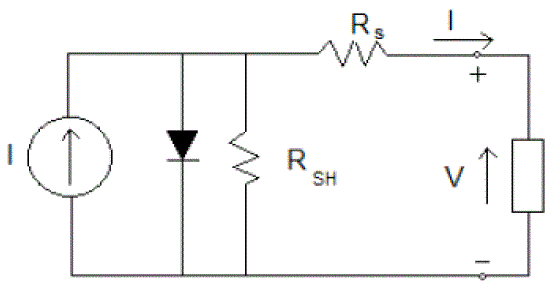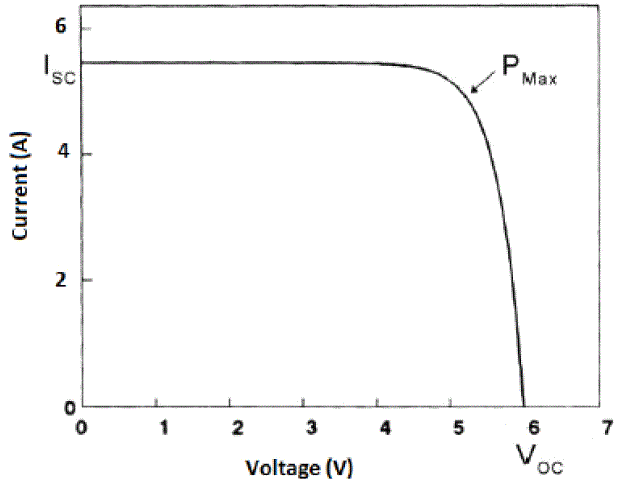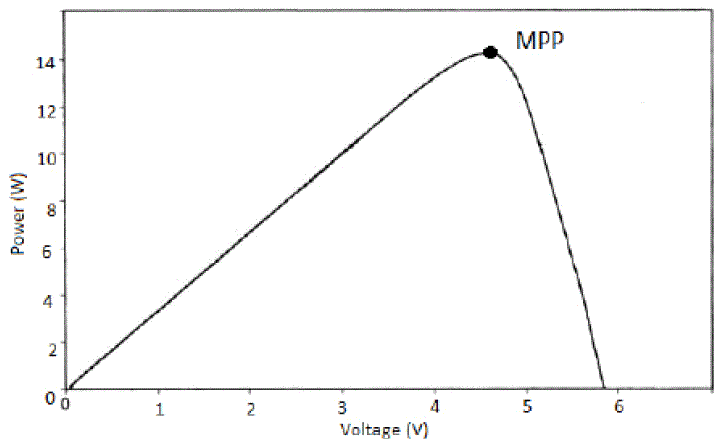Keywords
|
| Maximum Power Point Tracking (MPPT), Perturb & Observe technique (P & O), Photovoltaic cell (PV cell). |
INTRODUCTION
|
| The increasing global warming caused due to non-renewable resources, their increasing cost due to demand has forced people to think about alternate sources. The stock of conventional energy resources like fossil fuels, coal, etc. is on the decline, thereby paving way for the renewable resources like water, wind and the sun to find their utility. Since solar energy is clean and environment friendly, it has been hailed as a reliable form of energy. In earlier days, solar power was obtained by trapping the energy from the sun in solar devices. With the advancement in research and technology, the conversion of solar energy to electrical energy is done by concentrating the solar radiations on PV arrays. This conversion is made by the solar photovoltaic cells or the solar power plants. Many recent studies have shown that the conversion efficiency of these cells are around 19% to 30%. When a large number of these solar cells are used, it is essential that a maximum output power is extracted since the operation involves a large capital cost. Keeping this in mind, many MPPT methods have been developed to enhance the power of solar cells. Some of the popular algorithms or techniques of MPPT are Perturb & Observe(the Hill climbing method), Fractional Short Circuit Current method, Fractional open circuited voltage method, Incremental conductance method, Fuzzy logic control, Neural network, Differential Evaluation (DE) algorithm, Genetic algorithm and Improved Particle Swarm Optimization. In this paper, the basic model of a PV array system and the major MPPT methods have been discussed. |
BASIC MODEL OF PV ARRAY SYSTEM
|
| A photovoltaic cell is basically a semiconductor device that utilizes the concept of photoelectric effect to convert solar energy to electrical energy. When the energy band gap is exceeded by the photons' energy, electrons are generated leading to a current flow. Hence, electrical power is obtained from the PV cell. A PV cell is always forward biased. Generally, a number of PV modules are connected together in various combinations to meet the demand when the energy requirements is high. They are readily available in the market (with ratings of 50 W- 200 W). |
| A PV array is a combination of several solar photovoltaic cells connected in series and parallel. The series connection boosts the total voltage while the parallel connection helps in increasing the total current of the system. The basic model can be presented in the simplified manner: |
| The output current is expressed as: |
 |
| where I= current of PV cell, ISC= short circuit current, I0= diode's reverse saturation current, Q= charge of electrons, V= PV cell voltage, VD = voltage across diode, k= Boltzmann constant (1.38* 10-19 J/K), ID= diode current, Rs = series resistance, T= junction temperature and n= diode ideality factor. |
| The point at which maximum power occurs for a particular load is determined by the Maximum Power Point Tracking (MPPT) methods. This is done by studying the I-V characteristics curve of the cell. |
| Similarly, the P-V characteristics of the model can also be plotted. The output is maximum at the point MPP. |
LITERATURE REVIEW ON MPPT TECHNIQUES
|
| In order to obtain the maximum output power, the point at which it occurs is determined using the MPPT techniques. The choice of a particular technique depends on its cost and convenience. The MPPT system can be classified according to use of algorithms, power converters and connection type (standalone or grid connected). PERTURB & OBSERVE (Hill climbing method) |
| This method utilizes only one sensor i.e. a voltage measuring sensor to measure the voltage of PV system. It is named so because when the algorithm reaches very near to the MPP, it starts to perturb to both sides of the MPP. For this purpose, an error limit is approximately applied to it to arrive at the point. The huge irradiation is not taken into consideration, instead this effect is taken as the change in MPP giving rise to an increased error. It is cost effective and involves reduced time complexity. |
INCREMENTAL CONDUCTANCE METHOD
|
| Mohammed A. Elgendy et al. put forward this method uses two sensors, i.e. voltage sensor as well as current sensor to sense the array output voltage and current. |
| dP/dV]MPP = d(VI)/dV |
| The slope of the PV curve at the MPP equals to zero. |
| So, I + [V*dI/dVMPP]=0. |
| At MPP, the sum of the instantaneous conductance and the incremental conductance is equal to zero. The problem of irradiance is overcome due to which its cost increases. This algorithm consists of reference voltage perturbation (RVP) and direct duty ratio perturbation (DRP). A constant step size has to be chosen so that the noise effects on outputs are eliminated. The period of perturbation (changed by step size) is slightly higher than the settling time. For RVP, initial reference voltage taken should be the array's standard test condition value. Though it gives a fast transient response, it shows instability if the perturbation rate goes up. In case of DRP, initial duty cycle is set at 50% and the efficiency changes if transient response goes down. |
FRACTIONAL SHORT CIRCUIT CURRENT METHOD
|
| M. Dahmane et al. suggested the algorithm in which when the environmental conditions are varying in nature, the current at MPP is assumed to be directly proportional to the short circuited current. |
| IMPP = K*ISC |
| where K is a proportionality constant. The value of 'K' is evaluated according to the PV system being used. Isc is calculated by the current sensor after adding an auxiliary switch which shorts the system. The short circuit current is evaluated using Genetic Algorithm (GA). GA provides better energy output under suitable weather conditions. The Linear Inequality Matrix (LMI) is used to compare results. |
FRACTIONAL OPEN CIRCUIT VOLTAGE METHOD
|
| In this method, the voltage at the MPP is assumed to be proportional to the open circuited voltage under changing conditions of temperature and irradiance. |
| VMPP = k*VOC |
| where „kâÃâ¬ÃŸ is a constant and depends on the array characteristics. At different values of temperature and irradiance, empirical values of the VMPP are evaluated. Since Voc is measured, there is a power loss for a short time period. S.Yuvarajan et al. suggested an accurate MPPT algorithm that made very efficient use of mathematical equations derived from non-linear VI characteristics of the PV panel. |
FUZZY LOGIC CONTROL
|
| The fuzzy logic control employs the much efficient microcontrollers. The advantages of fuzzy logic are it does not require a mathematical model, the system nonlinearity (if any) is taken care of and it can also deal with irregular inputs. Takagi Sugeno (T-S) model method, devised by Chian-Song Chiu, is very popular. It is mostly applicable to standalone systems for which the T-S fuzzy model (the solar system), T-S fuzzy observer and the controllers are designed. The computations related to observer & controller are done using Linear Matrix inequalities. It is quite stable and also eliminates the problem of power chattering. |
| C.Larbes et-al. also suggested an intelligent control technology using fuzzy logic. Here, GA is implemented to increase the performance. |
NEURAL NETWORK
|
| When this concept is applied, it consists of three basic layers- input layer, hidden layer and the output layer. Any of the PV parameters (VOC, ISC) or parameters like temperature can be set as the input variables. The output variables are multiple signals (similar to duty cycle signals) so that the operation can be carried out closely at MPP. It can be implemented despite nonlinearity and changing parameters. B.L.Mathur and R.Ramaprabha proposed a ANN method, trained by a set of GA optimised I/P data. An increase in this trained I/P results in more output power. |
MODIFIED DIFFERENTIAL EVALUATION (DE) METHOD
|
| Mohammad Faridun Naim Tajuddin et al. proposed the modified Differential Evaluation method. This algorithm is a modified version of the DE algorithm and is applied whenever there is large & imprecise fluctuations in irradiance. The result of this method can also be compared with the Perturb & Observe method by means of simulation and mat lab. The merits of DE are its simplicity, clarity and its ability to reach at the global max point (the initial values are not taken into account). It has fast convergence, improved tracking capability and a limited no. of control parameters. |
DETERMINISTIC PARTICLE SWARM OPTIMIZATION (DPSO)
|
| This algorithm put forward by Kashif Ishaque and Zainal Salam, is an improved form of the Particle swarm optimization, where a direct control scheme is used to search the global peak (GP) by calculating the duty cycle. It operates in two modes- the local mode and the global mode. The already available GP is used in the local mode. Under partial shading, the global mode is operated, but this mode changes to the local one after a GP has been reached. It is highly accurate with an accelerated coefficient factor and comprises of control structures that are less complex. |
GENETIC ALGORITHM ADAPTIVE PARTICLE SWARM OPTIMIZATION (GAAPSO)
|
| This methodology was proposed by Liqun Liu and Chunxia Liu. GAAPSO involves a real time control which is implemented for multiple array system under the conditions of partial shading. The global peak is evaluated by the combination of PSO & Genetic Algorithm. A higher speed in tracking of MPPT makes it more efficient. |
PARALLEL TEST BENCH SYSTEM METHOD
|
| Weidang Xiao et al. came forward with this method, which was free from the demerits like simulators, artificial or natural sunlight, etc. This comprised of two modules, two similar dc-dc boost converters, digital controllers and battery. The P & O technique is implemented in the 1st module whereas for the 2nd module, centred differential and steepest descent method is used. The testing can be carried out for 15 days with an average of 8 hours/day. Since this is greatly affected by weather conditions, pair wise difference comparison makes it easier to compare results. |
OTHER IMPORTANT ALGORITHMS
|
| Eflichoisos Koutrouli and Frede Bababjerg suggested an innovative method that very well overcame the disadvantages of iteratively control method, by reducing the complexity and cost. In this method, the global MPP calculation was possible without considering the electrical characteristics and configuration of any given PV model. A dc-dc power converter is used which helps to control the output in such a way that it appears like a constant I/P power load. The advantages are that the tracking can be done irrespective of standalone or grid connected system. It can be also put into use with any existing control system. |
| Hung-I Hsieh et al. proposed an algorithm in which a high frequency PV pulse charger (with lead acid battery) working on a power-increment-aided incremental-conductance MPPT. The PV-PC is implemented by a boost current converter which when used with a PV module maximises he energy charging to the battery. |
| Zheng Shicheng et al. put forward a method known as constant voltage tracking (CVT). This included the analysis of the characteristics curve and the operation of PV array to arrive at desirable results. |
| Noppadol Khaehintung et al. also gave an idea of one adjustable self-organising fuzzy logic controller (SOFLC) for a solar powered traffic light equipment (SPTLE) which is integrated with MPPT system. It is cost effective as it uses low cost microcontroller. It uses boost converter for SPTLE if high performance is desired. |
CONCLUSION
|
| Indeed, the rate at which the modern man uses energy, all energy needs can be satisfied if we resort to solar energy. In the above paper, the basic concepts of a solar photovoltaic cell and its utility have been discussed. A detailed review on the various MPPT techniques to improve efficiency of PV systems has been done. |
Figures at a glance
|
 |
 |
 |
| Figure 1 |
Figure 2 |
Figure 3 |
|
References
|
- Tajuddin,M.F.N.,Ayob,S.M.,Salam,Z.,Saad,M.S., “Evolutionary based maximum power point tracking technique using differential evolution algorithm”, ElsevierEnergy and Building, Vol. 67, pp. 245 – 252, December 2013.
- Ishaque,K., Salam, Z., “A Deterministic Particle Swarm Optimization Maximum Power Point Tracker for Photovoltaic System Under Partial Shading Condition”,IEEE.
- Dahmane,M.,Bosche,J.,EI-Hajjaji,A., Pierre,X., “MPPT for Photovoltaic Conversion Systems Using Genetic Algorithm and Robust Control”, American ControlConference (ACC), 2013.
- Elgendy,M.A.,Zahawi,B.,Atkinson,D.J., “Assessment of the Incremental Conductance Maximum Power Point Tracking Algorithm”, IEEE Transl SUSTAINABLEENERGY, Vol. 4, NO. 1, pp.108- 117, JANUARY 2013.
- Liu,L., Liu,C., “A Novel Combined Particle Swarm Optimization and Genetic Algorithm MPPT Control Method for Multiple Photovoltaic Arrays at Partial Shading”,ASME, Journal of Engineering ResourcesTechnology, Vol. 135, Published on line December 2012.
- Ramaprabha,R.,Mathur,B.L., “Intelligent Controller based Maximum Power Point Tracking for Solar PV System”, International Journal of Computer Applications(0975 – 8887), Vol. 12,No.10, January 2011.
- Chiu,C.S., “T-S Fuzzy Maximum Power Point Tracking Control of Solar Power Generation Systems”, IEEE TRANS ENERGY CONVERSION, Vol. 25, NO. 4, pp.1123-1132, DECEMBER 2010.
- Esram,T., Chapman,P.L., “Comparison of Photovoltaic Array Maximum Power Point Tracking Techniques,”IEEETransactions on Energy Conversion, Vol. 22, No.2, June 2007.
- Xiao,W., Zeineldin, H.H.,Zhang,P., "Statistic and Parallel Testing Procedure for Evaluating Maximum Power Point Tracking Algorithms of Photovoltaic PowerSystems,", IEEE Journal of photovoltaics, Vol.3, No.3, pp.1062-1069, July 2013.
- Koutroulis,E.,Blaabjerg,F., “A New Technique for Tracking the Global Maximum Power Point of PV Arrays Operating Under Partial-Shading Conditions”, IEEEJournal of photovoltaics, Vol. 2, No. 2,pp. 184-190, April 2012.
- Larbes,C., Cheikh,S.M.A., Obeidi,T.,Zerguerras,A., “Genetic algorithms optimized fuzzy logic control for the maximum power point tracking in photovoltaicsystem”, Renewable Energy 01/2009; 34(10), pp. 2093-2100,2009.
- Hsieh,H., Hsieh,J.H., et al., “A Study of High-Frequency Photovoltaic Pulse Charger for Lead-Acid Battery Guided by PI-INC MPPT”, Renewable Energy Researchand Applications ,pp. 1-6, 2012.
- Zheng, S.,Wei,L., “Research and implementation of photovoltaic charging system with maximum power point tracking,” Indus trial Electronics and Applications,3rdIEEE Conference, pp. 619-624, 2008.
- Khaehintung, N.,Sirisuk,P., “Application of Maximum Power Point Tracker with Self-organizing Fuzzy Logic Controller for Solar powered Traffic Lights,” PowerElectronics and Drive Systems, 7th International Conference ,pp.642-646, 2007.
- Yuvarajan,S.,Shoeb,J., “A Fast and Accurate Maximum Power Point Tracker for PV Systems,” Applied Power Electronics Conference and Exposition,23rd AnnualIEEE Conference,pp.167-172, 200
|